Farewell, MoBell.
In the Early 1970s, Alfred Newman Beadle was commissioned to design the Mountain Bell Building on 3rd Street in Phoenix, Arizona. Mardian Construction was the contractor. It was a pure example of the International Style of architecture in Phoenix. In its time it was admired for its faultless lines, blue-black glass and general uniqueness among its more mundane neighbors. The blue-black midrise was also intended to have a sister-building across the plaza from it, each mirroring the other. This never materialized.
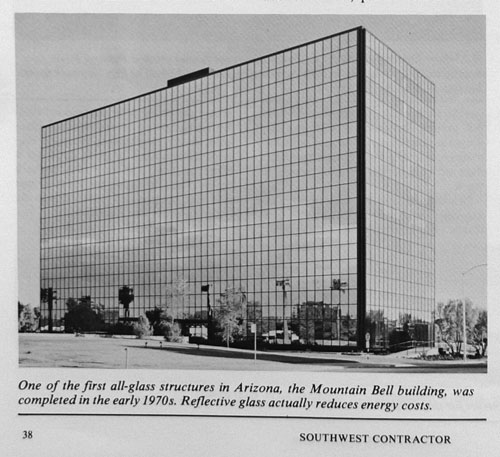
Over the decades, multiple ownerships, air quality / asbestos issues and general lack of maintenance made this mirrored monolith a prime target for acquisition during the real estate bubble in 2004.
Developer Joe Pinsonneault intends to transform it into another midrise campus for retirees called Montage. After reported efforts to rehabilitate it, decisive plans to demolish it were made public as early as 2008. Modern Phoenix members have been tracking this issue since 2005 and have known of the demolition permits since that time.
Architectural advocacy heavyweights made effort at the time to work with the city's Historic Preservation Commission and staff, along with the district's Council member (a mid-century fan himself), to influence the issue, but to no avail.
“What makes this tragedy sting so much is that the building had a shot at being economically viable. There was a top team of talent assembled to help this developer look at ideas. We came so close to having a Beadle mixed-use tower that the thought of it still pulls at my heart. I recall meeting one of the finance people for the developer on-site. We shared an overview of the Building and a history on Al Beadle he looked confused. His comments? “Frankly I don’t get it, it’s just another glass box high-rise. You see them all the time”.
Appalled, I asked him to really think about it. You see buildings with a glass curtain wall but Modernist buildings of this proportion? Reality is they are few and far between, but that’s what killed this building – the perception that these designs are common and infinitely replaceable. Of course they are not. Once lost the economics of design make it very hard to bring anything like them back. We lost a significant work by a Modernist American Architect. We also lost the memory of a civic and corporate optimism that invested in the local community. “Ma Bell” was special, and worth the effort to save.”
~ Scott Jarson
AZ Architecture
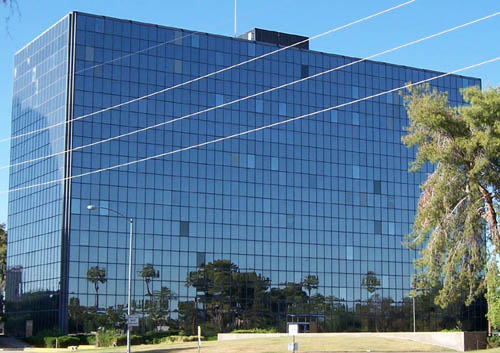
Around 2007, locals started to see the evacuated property decline even more. The black mirrored glass panes popped out like decayed teeth and the area had been fenced off for public safety. It stayed in this condition for what seemed like an eternity, losing the occasional pane in a slow march toward death. Like the architecture or not, it was commonly agreed to be an eyesore. There was something special, tragic and beautiful about the building's decline, like witnessing the gradual decline of Grecian ruins.
"Al Beadle and I spoke a number of times about the tragedy of what clients and future owners would do to their buildings, with a total disregard for the integrity of the original design. He warned me that it would happen to me sooner or later and of course it has! The Mountain Bell building had fallen into such disrepair that Al would have wanted it removed a lot soon than it was. I worked with Al through the zoning, planning, drawing and early construction of the building, it was the last project that i worked on for him before i opened my office. One of Al's biggest disappointments was that the twin building and parking structure were never implemented. He built his office buildings across the street so that he would be near the project."
~ Ned Sawyer
Architect
Documenting the demise of Mountain Bell over time became a hobby for many. Modern Phoenix received about three false alarms that the building would be going down THIS WEEKEND over the next two years.
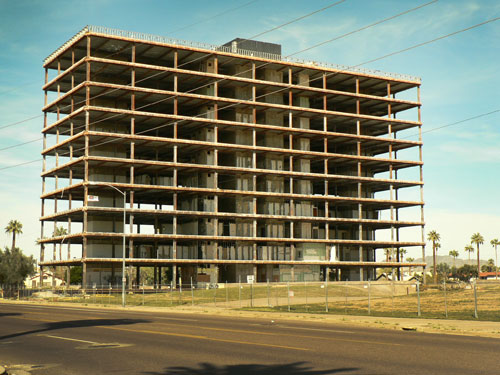
In 2009 asbestos abatement was completed and the building was stripped of its glass. Any passerby could find it littered across the asphalt of 3rd Street and crunching underfoot. Being shatterproof, the cubes of glass were largely harmless, however it was difficult not to notice how it built up in eerie blue drifts on the sidewalk and gutters of the sidewalk. With all of Mountain Bell's structure exposed, Phoenix got to observe her architecture in a brand new way.
"What is so sad is that no one could 'do right' by that historically important building; it was in a state of disrepair for years! What could be more disrespectful to one of Arizona's most important architects? If we don't see the value in a building as beautiful and delicate as the Mountain Bell building, then we don't deserve it."~ Suzanne D. Johnson
Executive Director, Gnosis, Ltd."Shortly prior to Al's death we spoke of the Mountain Bell building ... I paraphrase: Any or all of my buildings that have been neglected or mutilated would be better torn down."
~ Michael P. Johnson
In February Matthew and Alison King made a field visit to Mountain Bell to gather shattered glass for a sculpture to be given away at the Modern Phoenix Expo. They also returned to another endangered Beadle building, White Gates, to gather glass tiles. Both samples were placed in numbered scientific specimen jars.
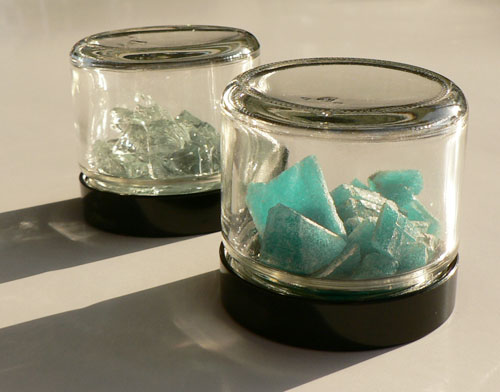
Half Empty / Half Full. Edition of four sculptures by Alison King, now held in the private collections of Lynda Maze and Peter Newton.
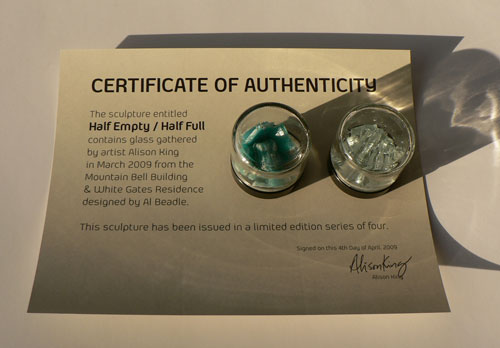
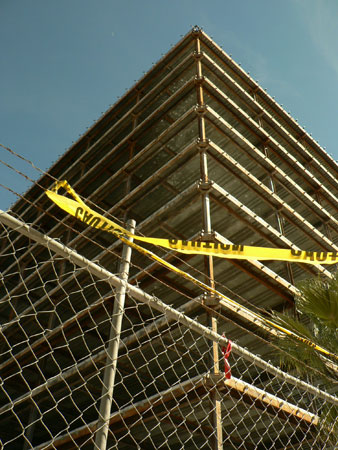
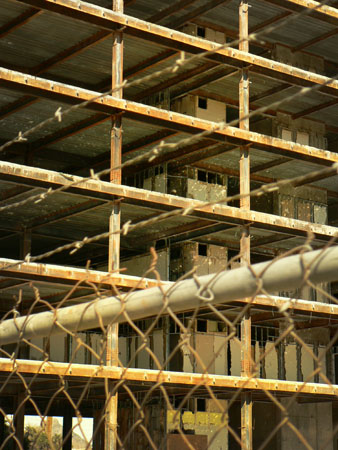
The elevator shafts showed the core structure and became a graffiti artist's canvas in the Summer of 2009.
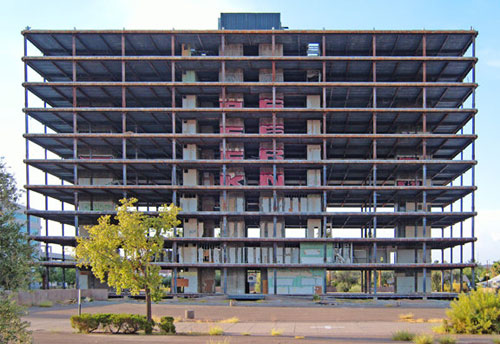
On September 25 official city documents in PDF spread like wildfire through the internet, outlining the implosion plans for Mountain Bell. Some neighbors were livid at the short notice. Facebook became abuzz with the news.
A major cable network The Learning Channel chose to film the event for a new series about a family-owned demolition business. It won't be long before we can watch the entire event again in HD from the comfort of our sofas.
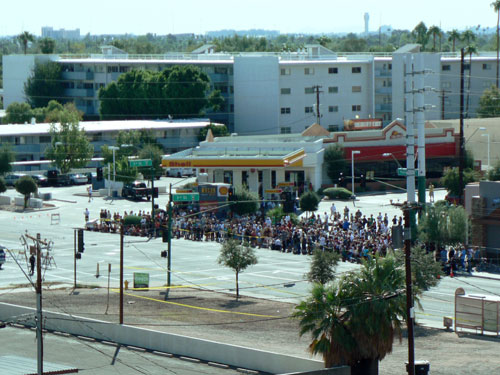
Crowds gathered by the hundreds on street corners, flushed out by Police after allowing a closer view earlier in the morning. Residents were allowed to remain in their homes.
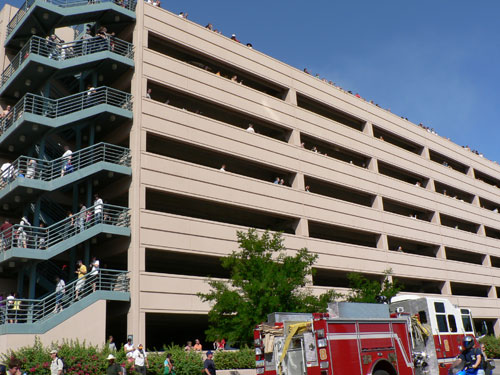
The Hilton Suites parking structure became an unofficial vantage point for the event as hundreds more poured onto its levels and set up cameras. Families were well represented in attendance as a free spectacle for the kids.
In Modern Phoenix's estimation, this is possibly the Valley's most well-documented architecture-related event in recent history. Facebook and Twitter were flush with citizen coverage of the day's events, and Channel 12 hovered in its copter to capture a unique vantage point. Bloggers and amateur videographers also captured their own points of view.
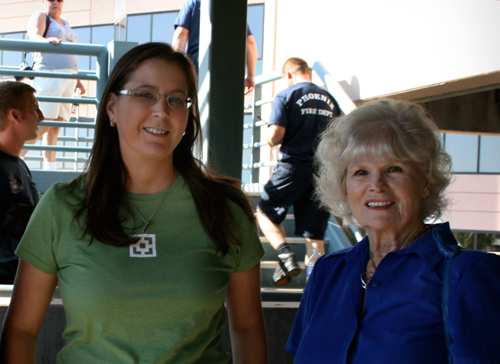
On the morning of September 27, 2009 Alison King captured Nancy Beadle's feelings on the occasion.
Alison: This is Alison King of modernphoenix.net here today with Nancy Beadle, wife of Alfred Newman Beadle, to observe the implosion of the Mountain Bell Building.
Nancy: Yes, we're very sad. That's progress I guess. It really was a beautiful building and Al loved it.
Alison: What made it special in its day?
Nancy: Well because it is an all glass building, it was all black glass. It looked like the black telephones. It was just a fantastic building.
Alison: What events have taken place to make it go down?
Nancy: At one point, after Al died, I understood the owners were going to make them into condos and I was advised: don't buy at Executive Towers, you should wait and buy at the Mountain Bell Building. So I did; I waited! Then finally, they weren't taking care of it. It just fell into disarray – and what do you do?
He designed his own office building right kittycorner at 3rd Street and Catalina so he could be there – because he was a hands-on architect and knew all about construction. He was there every day to find out what was happening.
Alison: And it had a great view! So how do you think Al would feel today seeing this end of an era?
Nancy: I think he would be a little bit sad. The funny thing is he did the Safari resort. Of course that had gone from one person to another for so long. Finally when he found out they were tearing it down he was happy. He said it should be, because it outlived its time. But Mountain Bell was so beautiful. It is just a shame that somebody couldn't do anything nice to it and retain it for Phoenix. But that's the way things go.
Alison: Thank you, Nancy.
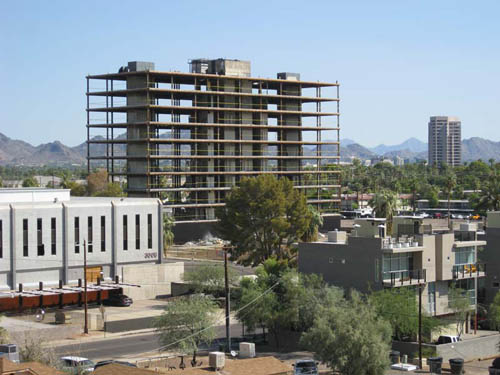
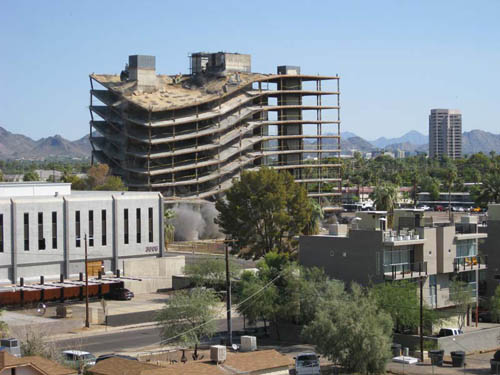
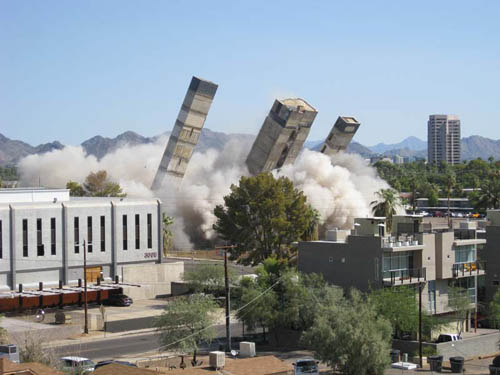
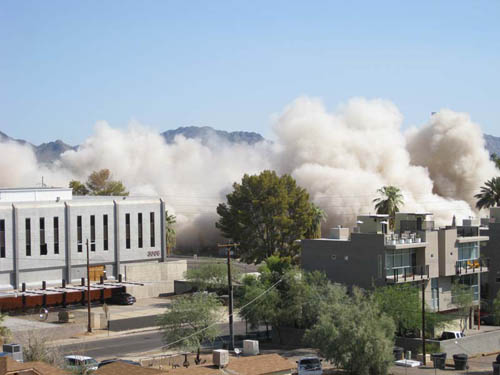
The crowd let out a cathartic cheer as it fell. All that was left was to recycle the rubble.
"Why would the implosion of architecture cause a crowd to cheer? I suppose if it is replaced by something better, it could be construed as positive. I do not know about future plans but the implied inability to recognize the re-purposing potential of an excellent architectural example does not inspire optimism. Given the physical degradation, I suspect Al would have approved the destruction. I confess I would rather have the building eliminated than risk a face lift by incompetent hands. Perhaps it is my imagination, but it seems more architecture is torn down to be replaced by mediocrity than the progressive alternative. One could argue the public does not value modern architecture, therefore let the majority rule. As expected, I would advocate the opposite. If one does not see the importance of something valued by an informed and knowledgeable few, it is incumbent on the person to attempt an understanding of those underlying qualities. I believe we call this approach: EDUCATION."
~ Eddie Jones, AIA
Jones Studio, Inc.
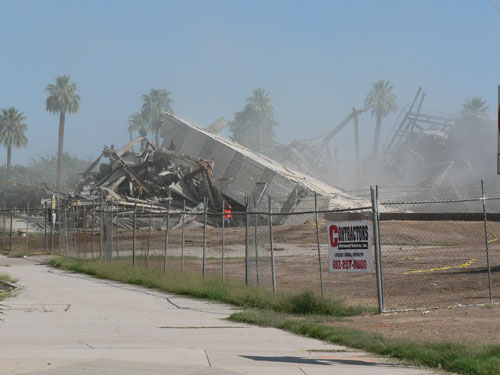
Within minutes, the police barricades were lifted and the spectators were allowed to get closer again.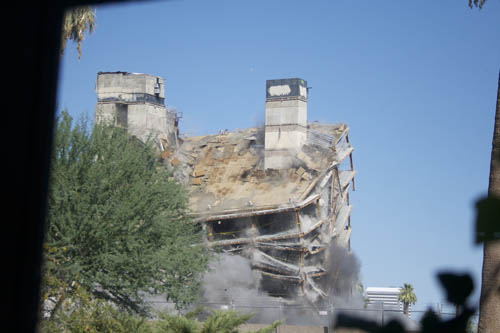
This terrifying shot was taken by resident Sam Feldman from his living room window, whose property abutted the implosion site. Can you even imagine the sight of this concrete mass falling toward your home?
"The Mountain Bell Building, like so much existing architecture (important or not) could have had a second life with some sensitivity and creativity. I doubt the owners of this building put much true creative effort into figuring out what this building, or its frame, could have become. And that is a shame, because even just the frame was interesting on its own — a skeletal language of typical high-modernism, still in perfect proportion, and ultimately showing its structure with perfect transparency.
I subconsciously have chosen to see the destruction of this building as a large format art installation about modernism, as well as how consciously PHX destroys its history: The building WAS beautiful at one time (stark, pure, and nearly in-human), then it was left alone, became shoddy, was reduced to its bare structure, and then destroyed. Each stage was sadly beautiful in its own way. Hopefully we'll learn to creatively save our treasures in the future. But perhaps it was too pure and stark to gain enough admirers around to save itself. Beadle might have grumpily understood its appearance wasn't for everyone."
~ Matt Salenger, RA
coLab studio
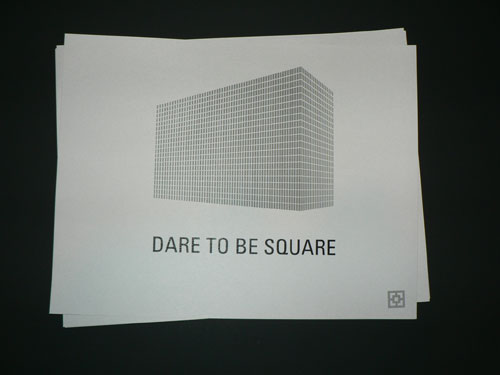
The evening before the implosion artist Alison King created a series of toner-drawings on card stock that commemorated the event. They were scattered throughout Phoenix locations and given to people she encountered that weekend.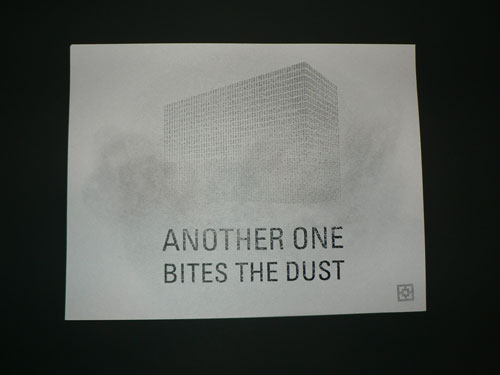
The ill-adhered toner was turned into a primitive charcoal-like substance, representing dust and the impermanence of anything we believe to be fixed. It is expected to only deteriorate more. Downloadable copies of this cubicle poster are available online for further manipulation. Original monoprints by the artist are available for FREE at Phoenix Metro Retro.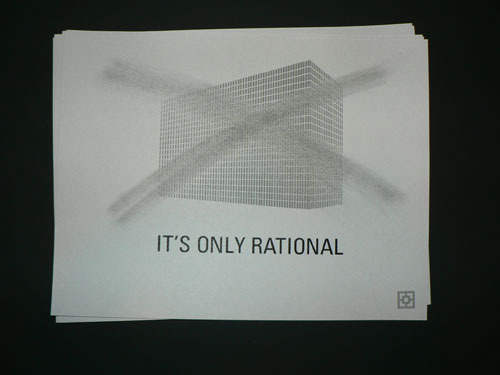
The Historic Preservation Office of the City of Phoenix has declined to comment on Mountain Bell, but this isn't deterring the preservation movement from persevering.
"It's sad to see another Beadle building bite the dust. I live on the 20th floor of Beadle's Executive Towers, and have served as chair of its historical committee since 2006. We are gradually restoring the building to its original appearance and in 2014, when it is 50 years old, will apply to have Executive Towers included on the National Register of Historic Places."
~ Richard Elardo
Historical Committee Chair
Executive Towers
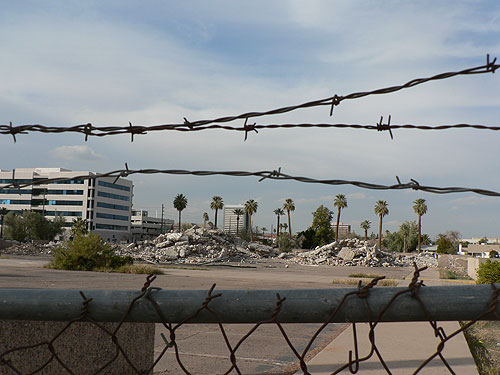
Since the demolition on September 27, 2009, the debris has remained unkempt as a tangle of rebar and concrete surrounded by barbed wire fencing. February marks more than four months of this blight in Midtown.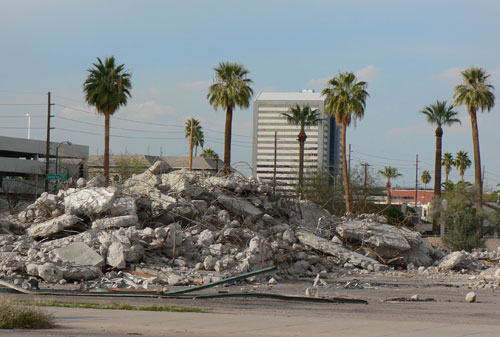
"The needless demolitions of the Mountain Bell Building, Washburn Piano Company, and Tempe 'gold dome' bank should serve as a wake-up call for mid-century modern fans to educate the public and policymakers of the genre's uniqueness and contributions to the growth and history of this Valley before more landmarks, large and small, drop like flies years before they're even eligible for historic status."
~Jim McPherson
Arizona Preservation Foundation
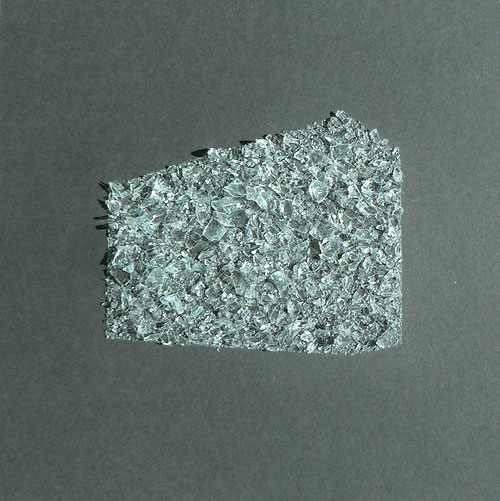
"Shatterproof" is a sculpture by Alison King made of pulverized glass fragments harvested from the ruins of Mountain Bell. It will be auctioned off on April 9th, 2010 in support of the Arts & Business Council of Greater Phoenix. "Shatterproof II" will be offered as a door prize at the Modern Phoenix Expo on April 10.
Nancy Beadle may have phrased it best: "What do you do?"
We don't just sit around.
We make a ripple in the pond!
Phoenix is notorious as a teardown culture—ANY building can be at risk and modern designs are no exception. Modern Phoenix has assisted as a communication forum and media outlet for the preservation of the Frank Henry Valley National Bank building site, The Tempe Dome Bank, Circles Records, and the White Gates residence by Al Beadle. We are ONLY able to succeed in these efforts IF WE KNOW ABOUT BUILDINGS IN DANGER! If we don't know, WE CAN'T HELP.
It is easy to feel helpless in persuading the actions of others. This checklist of small but significant actions will come in handy next time you become aware of an endangered midcentury modern property. Your action may have a ripple-in-the-pond effect. Will you be the hero brave enough to skip the first stone?
- Most importantly, tell somebody. Anybody. Start up a dialogue about why this property is important to you, and what you can do about it.
- Tell Modern Phoenix as soon as you can, even if you assume we already know. We might not. Either directly email the Editor (good start) or make a public announcement in the Marketplace section of our message boards (even better).
- Alert our member realtors who specialize in marketing midcentury modern properties. Ask them if they have already seen the property listed on our site. Members post sightings here all the time (even if they are not their own listings) Good places to start are:
- Go door-knocking, even if it is just one house or business. Talk with your neighbors. Inform them on the impact that teardowns have on the fabric of an entire community. There are tons of printable PDFs at the National Trust for Historic Preservation site that are particularly helpful for those without internet access. ModernPhoenix hosts a more locally-focused article on the topic of teardowns as well. Printouts work wonders. If the owner is elderly, boost web page printouts to a larger font size; they'll appreciate it.
- Use the GIS Maps at the County Assessor's website to find out who has recently purchased a significant home in your area, and use the information on public record to reach out to them (since sometimes they may not be living at the property site).
- Research the building or architect on Modern Phoenix. This will help you determine the building's cultural significance and whether others value it like you do.
- Contact the Phoenix Historic Preservation office and ask if they can help.
- Contact the Arizona Preservation Foundation and consider applying for a "Most Endangered Historic Places" listing. White Gates and Valley National Bank both earned the title last year and the designation has assisted in receiving positive publicity and aide.
- Contact the Western Office of the National Trust for Historic Preservation at 415.947.0692. Let them know and ask for their assistance in saving these resources as part of it’s Modernism + Recent Past Initiative.
- Use the National Trust for Historic Preservation to upload photos and videos for its "This Place Matters" campaign. Then send the link out to everyone you know for an instant viral campaign!
- Write your Mayor or city council member a note about how disappointing it is to not have any midcentury modern zoning overlays for Phoenix's most vulnerable neighborhoods. With proper budgeting for research on midcentury modern neighborhoods, homeowners would become more aware of the value of their own homes, and become less motivated to sell for teardown prices.

